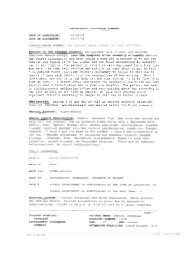C - Organized Mobbing
C - Organized Mobbing
C - Organized Mobbing
You also want an ePaper? Increase the reach of your titles
YUMPU automatically turns print PDFs into web optimized ePapers that Google loves.
In sum, then, the Stasi tried to influence almost all aspects critical to the<br />
formation of dissident institutions: understandings and their validation, re-<br />
sources necessary for action, the means of projectively articulating actions<br />
across space and time and with it the size and shape of networks. Given that<br />
these efforts were in theory rather encompassing, two questions emerge:<br />
"were there any limits to these efforts?" and "how effective were they in<br />
fact?" The following two sections provide some answers to these questions.<br />
Were there limits to decomposition?<br />
Particular officers and departments in the Stasi were not content with the<br />
means of decomposition provided to them through directive 1/76. Well<br />
documented is the case of section 4 (responsible for church affairs) of de-<br />
partment XX of the Berlin district office of Stasi, which saw itself as a kind I<br />
edly by the ministry's "central group for analysis and information" (ZAIG)<br />
(BStU MfS-ZAIG 13748).~~ Department XX of Stasi's Berlin district office<br />
was deeply steeped in efforts to control Berlin's ever-expanding peace, civil<br />
rights, and environmental movements. Among others, section 4 of department<br />
XX had taken on Rainer Eppelmann as well as his blues-mass collaborator<br />
and IFM member, Ralf Hirsch. During the 1980s many, perhaps even<br />
most PUT-casework leading officers, were frustrated about their difficulties<br />
with closing cases. After all, their ability to bring casework to an end was a<br />
formal bureaucratic yardstick for personal and organizational performance<br />
reviews even though it was quite clear that PUT cases were unlike others.<br />
AS I mentioned above, the possibility to close cases through the initiation of<br />
legal procedures became increasingly blocked for political reasons. At the<br />
same time, however, the regular means of decomposition iust described did<br />
not produce the desired effect either.<br />
These frustrations ran particularly high in Berlin, where the size of the<br />
Problem strained the Stasi beyond its organizational capacity. Still, the officers<br />
were charged with the task of stopping PUT, and they took this very<br />
33. The material presented in this file is interesting for other reasons, too. It provides insights<br />
nto Stasi's bureaucratic culture, including the competition between various departments. It<br />
also shows how some individual Stasi officers could use their powers to their own advantage<br />
Stealing from the perceived enemy, here the Protestant Church. Interestingly the same of-<br />
ficers who were particularly active in coming up with violent means of decomposition sought<br />
'0 reward themselves with illicit material privileges. I





